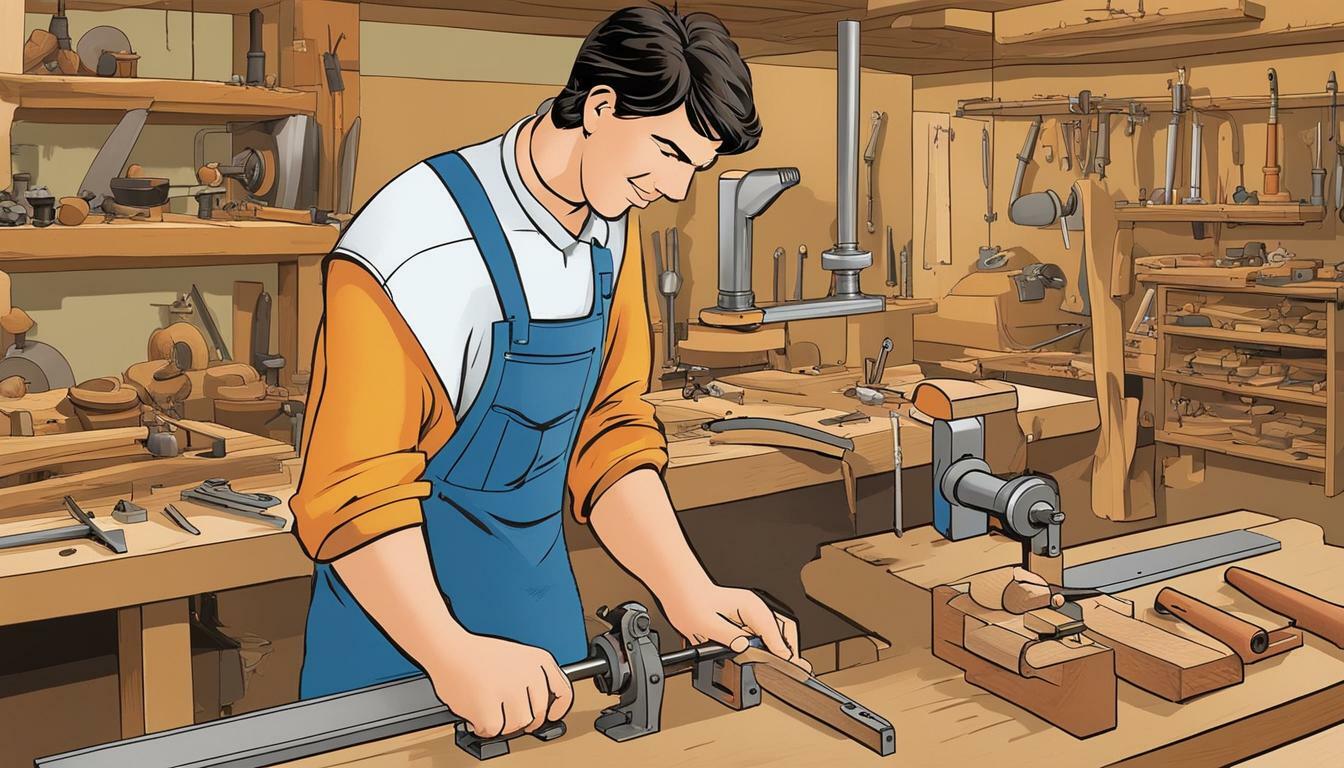
As a woodturner, one of the most critical aspects of achieving precision and efficiency in your craft is ensuring your tools are sharp. Blunt tools not only make your work more challenging but also increase the risk of injury. That’s where lathe tool sharpening jigs come in handy. These jigs are designed to help you sharpen your tools with ease and accuracy, making your woodturning experience more enjoyable and safe.
But not all lathe tool sharpening jigs are created equal. It’s essential to choose high-quality jigs that are made in the USA. These jigs are manufactured to strict quality standards, ensuring you get the best possible results every time you sharpen your tools.
Key Takeaways:
- Lathe tool sharpening jigs are essential for achieving precision and ease in woodturning.
- High-quality jigs made in the USA provide the best results.
Understanding Lathe Tool Sharpening Techniques and Angles
Sharpening lathe tools is a critical aspect of woodturning. Proper sharpening techniques and angles are essential for achieving precise and efficient cuts, allowing woodturners to create beautiful and high-quality projects.
There are several lathe tool sharpening techniques, each with its pros and cons. The traditional method involves using a bench grinder to sharpen the tool by hand. This technique can be time-consuming and requires significant practice to achieve consistent results. Another technique involves using a sharpening system that consists of wheels and a motor, which helps woodturners sharpen their tools quickly and efficiently.
When it comes to sharpening angles, the most common angles used for lathe tools are between 35 and 45 degrees. These angles help to achieve a clean and efficient cut. However, the angle chosen depends on the specific project and wood type being used. Some other factors that influence the sharpening angle include the type of lathe tool being used, its shape, and the woodturner’s personal preference.
Understanding Lathe Tool Sharpening Techniques
One popular technique for sharpening lathe tools involves using a grinding jig. This jig can be adjusted to achieve the desired angle and can help achieve a consistent bevel. Another technique is using a diamond sharpening stone, which is efficient for achieving sharp edges without degrading the tool’s shape.
A lathe tool sharpening kit is also a useful tool for woodturners, as it offers a variety of sharpening stones and jigs that can be used for different types of lathe tools. Additionally, some woodturners prefer to use negative rake scrapers, which offer a sharper cutting edge but are more challenging to use than traditional lathe tools.
Exploring Lathe Tool Sharpening Angles
Sharpening angles play a vital role in achieving the desired outcome when woodturning. For instance, a gouge tool could require a different angle than a skew chisel, depending on the project’s needs.
Sharpening angles can be categorized into three types: primary, secondary, and bevel angles. The primary angle is the angle of the tip of the tool, while the secondary angle is the angle at which the tip is ground. The bevel angle is the angle between the bevel and the tool’s tip.
It is crucial to achieve a consistent angle when sharpening lathe tools to prevent the tool from becoming uneven and losing its shape over time.
Using high-quality sharpening jigs and following proper sharpening techniques and angles can help woodturners achieve precise and efficient cuts, resulting in beautiful and high-quality projects.
Exploring Lathe Tool Sharpening Equipment and Methods
Lathe tool sharpening is an essential aspect of woodturning, and having the right equipment can make all the difference. In this section, we will explore various types of lathe tool sharpening equipment and methods, including lathe tool grinding jigs and sharpening systems.
Lathe Tool Sharpening Equipment
Lathe tool grinding jigs are an excellent starting point for any woodturner looking to achieve precision and ease in sharpening. These jigs come in various shapes and sizes, designed to sharpen different types of lathe tools, such as gouges, scrapers, and parting tools. Some popular types of lathe tool grinding jigs include Wolverine, Vari-Grind, and Woodcut Tru-Grind.
Sharpening systems are another popular type of lathe tool sharpening equipment. These systems are designed to provide a complete sharpening solution, including grinding, honing, and polishing. Some well-known sharpening systems include Tormek, Work Sharp, and Jet. While sharpening systems are more expensive than jigs, they provide a more comprehensive and efficient sharpening experience.
Lathe Tool Sharpening Methods
Once you have the right equipment, it’s essential to understand the different methods of lathe tool sharpening. The two most common methods are using a bench grinder and using a sharpening system.
Using a bench grinder involves mounting the lathe tool grinding jig on the grinder’s tool rest and grinding the tool’s bevel to the desired angle. While this method is relatively fast and straightforward, it requires a bit of practice to get the feel for the grinder’s movement and the correct angle of grinding.
A sharpening system, on the other hand, provides a more foolproof method of sharpening. The system guides the tool precisely through the sharpening process, ensuring a consistent bevel and angle. These systems take more time to set up and can be more expensive, but they provide a superior sharpening experience overall.
Ultimately, the best lathe tool sharpening method will depend on your personal preferences and budget. Experimenting with different methods and equipment can help you find the perfect combination for your needs.
Innovative Ideas for Lathe Tool Sharpening
Sharpening your lathe tools can become a fun and creative process once you’ve mastered the basics. Here are some innovative ideas to take your lathe tool sharpening skills to the next level:
- Experiment with different angles: While traditional lathe tools are sharpened at a 45-degree angle, you can experiment with different angles to achieve different effects in your woodturning. For example, sharpening at a steeper angle can create a more aggressive tool that’s great for making roughing cuts, while a shallower angle can provide more precision for finishing cuts.
- Use specialized jigs: There are many specialized jigs available in the market that can help you achieve specific cuts. For example, you can use a skew jig to sharpen your skew chisels or a bowl gouge jig to sharpen your bowl gouges. These jigs are designed to hold your tools at precise angles, allowing you to achieve consistent and accurate results.
- Try sharpening by hand: While sharpening jigs can be a great time-saver, sharpening by hand can actually be more precise and give you greater control over the process. With practice, you can learn to sharpen your tools by hand quickly and efficiently, achieving razor-sharp edges every time.
- Make your own jigs: If you’re feeling particularly crafty, you can even make your own sharpening jigs. There are many resources available online that can help you create jigs that are tailored to your specific needs.
These innovative ideas for lathe tool sharpening can help take your woodturning to the next level. Remember to always prioritize safety and choose the method that works best for you and your tools.
Conclusion
In conclusion, mastering lathe tool sharpening is crucial for achieving precision and ease in woodturning. By using high-quality lathe tool sharpening jigs made in the USA, woodturners can achieve consistent results and support local craftsmanship.
Understanding the different lathe tool sharpening techniques and angles is essential for achieving precise cuts and minimizing material waste. Along with using the right sharpening equipment and methods, woodturners can also experiment with innovative sharpening ideas and techniques to enhance their skills and achieve more efficient results.
Whether you’re a novice or an experienced woodturner, effective lathe tool sharpening can make a significant difference in the quality of your work. So, invest in quality jigs, practice proper techniques, and experiment with new ideas to take your woodturning skills to the next level.
FAQ
Q: What are lathe tool sharpening jigs?
A: Lathe tool sharpening jigs are tools used to hold and position lathe tools at the correct angles for sharpening. They help ensure consistent and precise sharpening, resulting in improved woodturning performance.
Q: Why should I use lathe tool sharpening jigs?
A: Using lathe tool sharpening jigs offers several benefits. They provide a stable and secure platform for sharpening, allowing for accurate control over the sharpening process. They also help maintain consistent angles, which is crucial for achieving optimal cutting performance and prolonging the life of your lathe tools.
Q: Are all sharpening jigs suitable for all lathe tools?
A: Not all sharpening jigs are compatible with every type of lathe tool. It’s important to choose a jig that matches the specific needs of your lathe tools. Some jigs are designed for specific types of tools or angles, so it’s essential to consider compatibility when selecting a sharpening jig.
Q: Can I sharpen my lathe tools without a sharpening jig?
A: While it is possible to sharpen lathe tools without a sharpening jig, using a jig provides greater precision and consistency. A sharpening jig ensures that your tools are sharpened at the correct angles, resulting in improved cutting performance and reducing the risk of damaging your tools.
Q: How do I choose a high-quality sharpening jig made in the USA?
A: When selecting a sharpening jig, it’s important to look for one made with high-quality materials and craftsmanship. Check for reviews and recommendations from trusted sources. Additionally, choosing a jig made in the USA supports local businesses and craftsmanship.
- Delta Midi Lathe 46-250 Performance - August 27, 2023
- Understanding the Different Parts of a Lathe Machine - August 27, 2023
- Explore Different Lathe Tool Holder Types for Your Projects - August 27, 2023
